Question of Media-Justice
- In Society
- 07:19 PM, Oct 08, 2017
- Myind Staff

Question of Media-Justice
EXAMINING OBJECTIVITY AND NON-PARTISAN CHARACTER OF MEDIA WHILE COVERING ATROCITIESON SC (DALIT) AND MINORITIES: A REPORT OF CASES BETWEEN 2015-16

MARCH 2017
PUBLIC POLICY RESEARCH CENTRE
Under the guidance of
Dr Vinay Sahasrabuddhe
Research by
Mr. Shubham Verma
Acknowledgements
Mr. Balbir Punj
Mr. Santosh Gupta
Mr. Swadesh Singh
Mr. Abhinav Prakash
Mr. Amlan Dutta
Ms. Vidushi Sahani
March 2017
All rights reserved. No part of this research report may be reproduced or utilised in any form and by any means, electronic or mechanical, including photocopying, recording or by any information storage or retrieval system, without permission in writing from the publisher.
Contents
|
Forward |
1 |
||
|
1. |
Background |
3 |
|
|
2. |
About Research |
4 |
|
|
|
2.1. |
Objective and Scope of the study |
4 |
|
|
2.2. |
Research Base |
4 |
|
|
2.3. |
Research questions |
5 |
|
|
2.4. |
Methodology |
5 |
|
3. |
The Question of Media Justice – A Comparative Study |
5 |
|
|
|
3.1. |
Statistics on Incidents of murder during Communal disputes |
6 |
|
|
3.2. |
Statistics on Incidents of atrocities against SC Youth |
8 |
|
|
3.3. |
Statistics on Incidents of suicide due to caste based discrimination |
9 |
|
4. |
Derivations and Observations |
10 |
|
|
5. |
Concluding Remarks |
15 |
|
|
6. |
Recommendations |
16 |
|
|
References |
18 |
||
Foreword
Justice to the reader through sacred news and credible media!
At least in olden days, the first lesson that the any student of journalism had to learn was about the fundamentals of news reporting. And one of the cardinal principles that teachers used to tell them was that ‘every news is sacred’! This sacredness was about keeping it clean, reporting what has actually happened and ensuring that ‘views are in no way mixed with news’ making it highly adulterated and thereby hampering the purity of the news delivered.
But today, this may seem as unthinkable. News, whether in print or in electronic media, today - more often than not - is anything but pure news.
Renowned media theorist Marshall McLuhan introduced the phrase “the medium is the message” in his book “Understanding Media: The Extensions of Man”, published in 1964. McLuhan proposes that a medium itself, not the content it carries, is the message. He said that a medium affects the society not only by the content delivered by the medium but also by the characteristics of the medium itself. Characteristics of medium (or Media) could be decided by the ownership, ideology and other factors.
This research report is an attempt to understand the recent and reported atrocities on SC(Dalit) and minorities and the treatment given to them by the media. This research examines the objectivity and non-partisan approach of the news media organizations while reporting certain cases of reported atrocities on persons belonging to the Dalit and Minority communities in last two years. It seems from the findings of this report that some incidents of atrocities were chosen and singled out for disproportionate coverage as against similar incidents happened in other parts of the country. This kind of biased and partisan reporting poses three serious threats. Firstly, it denies Media Justice to those who are at the receiving end of allegations that are yet to be proved. Secondly, it undermines the importance of similar such incidents of almost equal gravity doing injustice to those who faced discrimination, injustice and violation of human rights. Thirdly, this tendency very seriously hampers the credibility of mainstream media.
Denial of ‘Media Justice’
In the world of ‘media democracy’, where ‘media-trial’ is a regular phenomenon, ‘media-justice’ is often denied in a particular manner in three different ways. These ways are as follows
- Indulgence in Politics of Vocabulary, where similar actions are described in different terminologies. Using a particular set of words for particular group only amounts to a crass denial of media justice. While Edit Page of any newspaper is a place to express and shape opinions, news requires to be unadulterated. However, many journalists use words and phrases that are either discriminatory or judgmental in nature.
- Biased placement, involving disproportionate or uncalled for importance or denial of importance based on the biases of the persons involved in placing of news.
- Disproportionate highlighting through extra-ordinary column-centimetre space given repeatedly.
To understand whether the Media Justice was really denied to sections of Political Parties and the respective State Govt.s, the research team studied 400 news items of five newspapers of English and Hindi, news websites, National Crime Record Bureau’s report from 2009 to 2015 and National Minority Commission report from 2011 to 2015. The report includes comparative study of most highlighted and wantonly ignored cases against SC(Dalit) and Minorities during current NDA government.
Three Cases
The three widely publicised cases that of the unfortunate suicide of Rohith Vemula, flogging of SC youths at Una and events leading to the tragic death of Akhlaq in a lynching case have been picked for a comparative analytical study. The focus of this research was to find out as to whether media has handled these and exactly similar cases in almost same span of time even-handedly. It was a dispassionate study to understand as to how, a large section of media adulterates news with views and provides a coloured, prejudiced and biased news causing severe damage to its own credibility. Besides, by choosing to ignore similar incidents during almost the same period, victims in those cases are also discriminated as atrocities and injustice to them remains in the dark, thanks to selective media attention.
This is perhaps the first research of this type. Let’s hope that this generates some debate about the need to restore sacredness of news, credibility of the news-provider and justice to the reader.
Vinay Sahasrabuddhe (MP)
Honorary Director, PPRC
1. Background
Our nation has entered a phase of political stability, better fiscal conditions and rapid growth of the economy. With several innovative measures and good governance reforms, the government has raised the bar with people’s expectations soaring to greater heights. Special schemes for several sections of the society have been introduced to ensure inclusive and sustainable development of the society as a whole. India is world’s youngest democracy, but the Indian culture and history has lived the basic tenets of democracy since ages. Post independence, media – called the fourth pillar of democracy – went beyond the role of information dissemination to creating public awareness. Media trial and media activism has taken up inevitable role in the democracy.
In the light of current scenario, if news reports were to be indicative of the state of the nation, it would seem that the social fabric of the country is in upheaval. Way of media reporting has the power to distort and manipulate public opinion. The fourth pillar of our democracy can turn out to be a foe, if it colours the news with personal biases and adulterates facts and public order. Presently, certain media coverage gives the sense that atrocities against the SC (Dalit) and the minority communities have increased manifold in recent times.
Hence the aim of this research was to analyse the anti-Dalit and anti-Minority rhetoric prevalent in the country in the light of facts and evidence. Through a comparative study of reporting of the most highlighted cases against SC (Dalit) and Minorities that dominated the socio-political discourse of the country in last 2years (2015, 2016), against the under reported incidents of similar nature in the same time frame, this analysis was done. So, this paper presents the analysed data of reporting a particular incident(s) in newspapers, atrocity crime statistics from NCRB and NMC Reports to understand the overall trend.
In this report, the idea of media justice is also verified on several parameters. Media has crucial role in building public opinion and creating awareness amongst the citizenry. Unbiased, unadulterated and ethical reporting forms the pillars of media justice. Mixing of one-sided views with news, and selective reporting is largely denying the readers of media justice. Nevertheless, if such reporting at large incites social unrest in the country, caters to politics of appeasement or pandemonium and hurts national integrity, then such a compromise with media justice is ultimately killing the true spirit of media.
The even handedness of reporting news backed with facts and evidences without any colouring of opinions is justice driven media. These media ethics have been defined to strengthen the democracy and national integrity. Thereby this report emphasizes keeping media justice above contemporary popular needs of media. Ultimately, the idea of media justice strengthens the role of the fourth pillar of democracy and advocates its credibility in the society and amongst the citizenry, in the process of serving the nation at large.
2. About Research
2.1. Objective and Scope of the Study
This study will attempt to analyze and enquire into the objectivity and non-partisan character of the print media while reporting cases on atrocities against the SC (Dalit) and the minority communities. While there are several scholarly works on the coverage of atrocities against SC (Dalit) and minorities in news media, no major analytical research work has been produced on the coverage of atrocities against SC (Dalit) and minorities in reference to the major incidents in last two years. This research has taken into account eight cases including the three key cases - Dadri lynching, Rohith Vemula suicide and Una flogging, to understand the patterns, weightage given in news coverage while reporting such cases.
Table 1: Cases selected for Comparative analysis
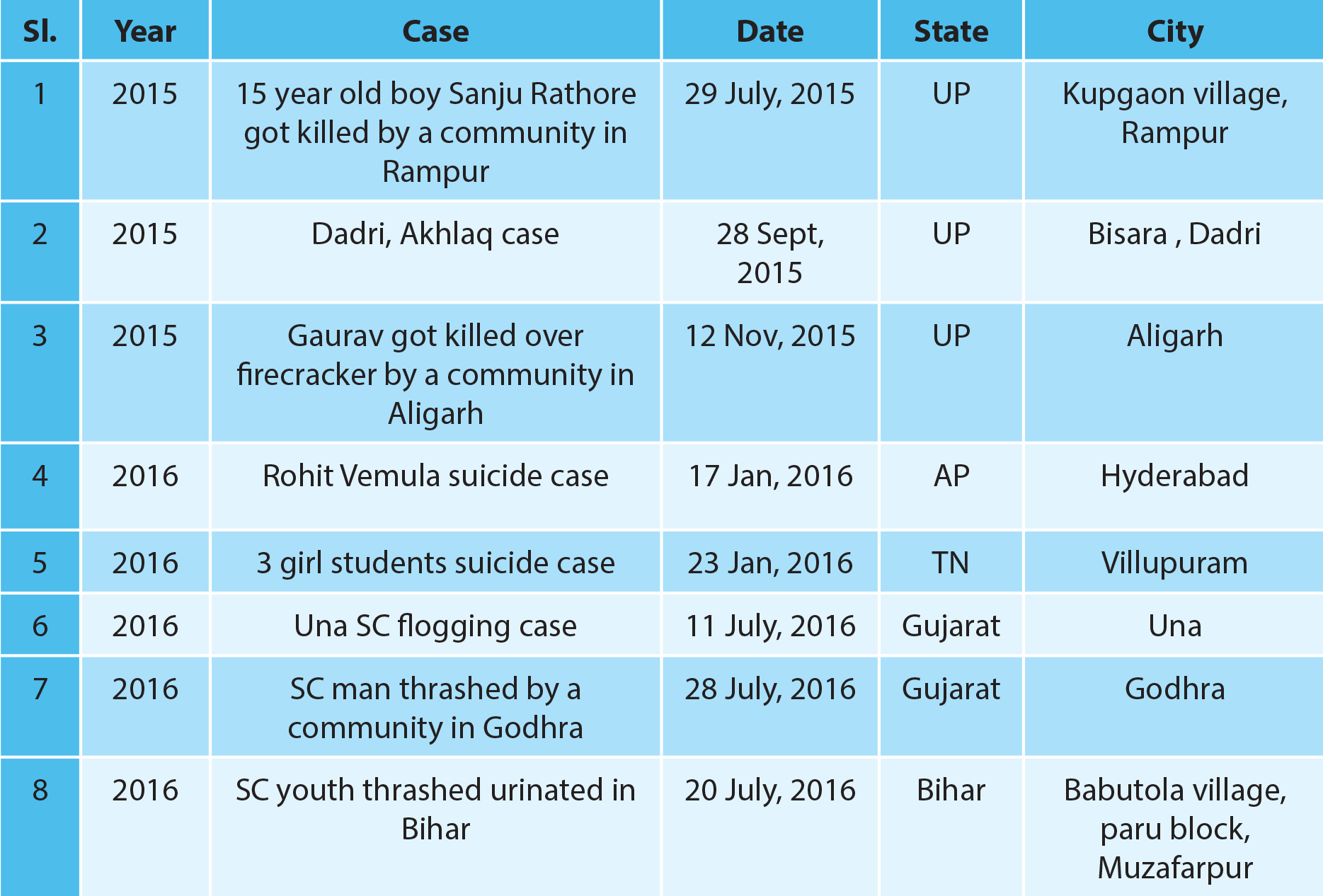
2.2. Research Base
In order to meet the objective of the study, 5-popular widely read newspapers were taken as base for analysis. The 5-newspapers are - The Hindu (Chennai), Indian Express (Delhi), The Times of India (Mumbai), Hindustan (Delhi), Jansatta (Delhi). In this comparative study, these five newspapers were scanned from the starting date of the incident to the next 10 days for the said eight cases. So, 400 news items (eight cases, five newspapers and 10 days, i.e. overall 5x8x10) were scanned and analyzed.
2.3. Research Questions
a) How were the incidents of atrocities against the SC (Dalit) and the Minorities covered by the news media organizations in the last two years?
- Were media organizations selective in covering the atrocities?
- Whether media-justice was compromised in the process?
2.4. Methodology
The approach for this research report has been qualitative and it is primarily a comparative and analytical research. The data has been collected through primary as well as secondary sources, including methods of library research, observational analysis, expert interviews and analysis of different news items and reports. Basically, it is a comparative study of key highlighted cases against the SC (Dalit) and the minorities in last two years (2015, 2016) against the under-reported incidents of similar nature, tempo in the same time frame. Case variation, purposive stratified sampling methods have been used for sampling. Focused content analysis of selected newspapers which covered news items of two years has been done. In order to compare and quantify the quantum of coverage, some other similar cases were selected. Ten days of coverage from the date of incident were taken to quantify the results.
- he Question of Media Justice – A Comparative Study
The picture in people’s minds about the world is significantly influenced by mass media, both what those pictures are about and what those pictures are. The agenda set by the mass media also has significant implications beyond the general image created in people’s minds. In the original, traditional domain of agenda-setting, the salience of public issues, there is some considerable evidence that the shifting salience of issues on the media agenda often are the basis for public opinion about the overall performance in office of a public leader.i
The role of media in shaping the public opinion is very important. A large number of people in the country are influenced by the news covered by mainstream media. Media has the power to influence the people or shape the narrative of any society. The question of Media Justice follows that whether media reporting is unadulterated, pure and factual or it reflects more of personal biases and colours the news to create a particular type of public opinion at large.
In order to study the approach of media reporting and understand the question of media justice put up for this research, 3-key cases of atrocities against SC and minority community in last two years (2015, 2016) have been taken into consideration for analysis -
- Dadri: Akhlaq Murder Case
- Hyderabad: Rohith Vemula Suicide Case
- Una: Dalit flogging Case
These cases were discussed widely in the media and attracted considerable political and civil society interest. These cases did widely set the socio-political narrative for a considerable time-span and have become a cover page of atrocities against SC and Minorities in last 2-years (2015, 2016). Against these three incidents selected for the study, similar five incidents that occurred in the same timeline were taken for comparative analysis in terms of amount of coverage given by media houses. The research base (Section 2.2) comprises 5-leading newspapers of the country, taken for content analysis here. Table-2 below, exhibits list of paired cases for comparative analysis.
Table 2: Pairing of similar cases for comparative analysis
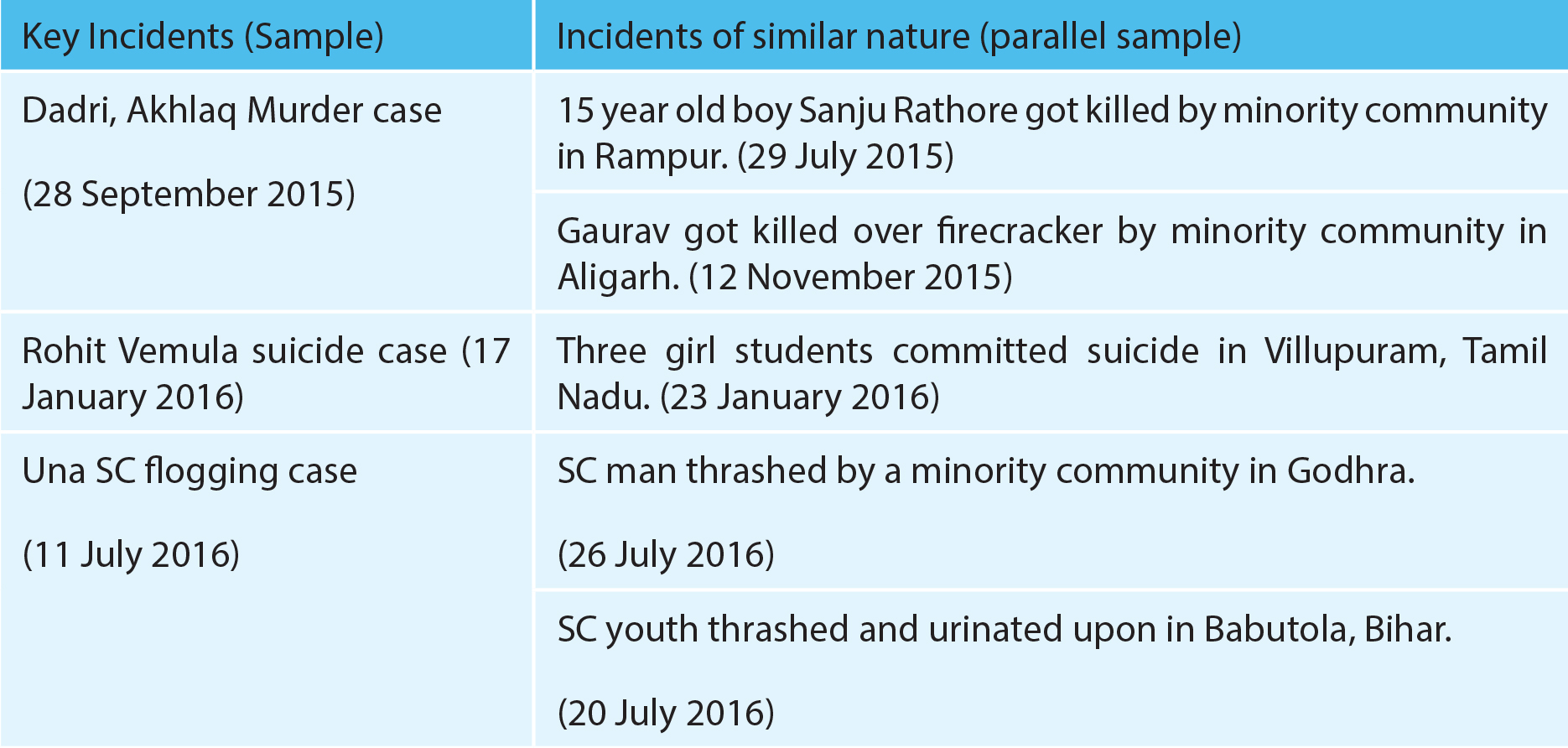
For this comparative study, the five selected newspapers were analyzed from the first date of incident to the next 10 days. Similarly, the page number on which the news appeared for each of these newspapers was also taken into consideration. The analysis of data reflects the position of contemporary media houses in delivering media justice and its role in shaping public opinion. The study involved research of 400 news items to understand the same.
3.1. Statistics on Incidents of murder during Communal disputes
Sample Incidents - Dadri, Aligarh and Rampur murder cases:
- Akhlaq murder case, Dadri (28 September 2015, UP): A 50-year-old man, Mohammad Akhlaq, was beaten to death and his 22-year-old son severely injured in UP’s Dadri, allegedly by residents of Bisara village, after rumours spread in the area about the family storing and consuming beef.ii
- Gaurav murder case, Aligarh (12 Nov 2015, UP): An undeclared curfew-like situation prevails in Aligarh after the death of a 22-year-old youth in communal clash. Things worsened as a reported incident of eve-teasing on ‘Bhai Dooj’ in Sarai Miyan and Kailash Gali took a communal overtone leaving a youth injured. He later succumbed to his injuries. iii
- Sanju Rathore murder case, Rampur (29 July 2015, UP): Cattle belonging to a member of the majority community were grazing in the field of a member of the minority community leading to a scuffle between the members of the two communities. Two Villagers Jitendra Singh and Raju Singh sustained severe injuries in the fight. Later in the evening the members of the minority community opened fire at the religious site of the other community. Amidst firing, Sanju Rathore, 15, sustained bullet injuries on his neck and died on the way to hospital.iv
The cases were selected for comparative study as all these three incidents took place in Uttar Pradesh in the same time period (i.e. within a period of six months) and all were murders that had escalated into community clashes. Figure-1 exhibits the analysis in terms of total number of news items for a particular case and number of pages used over 10 days.
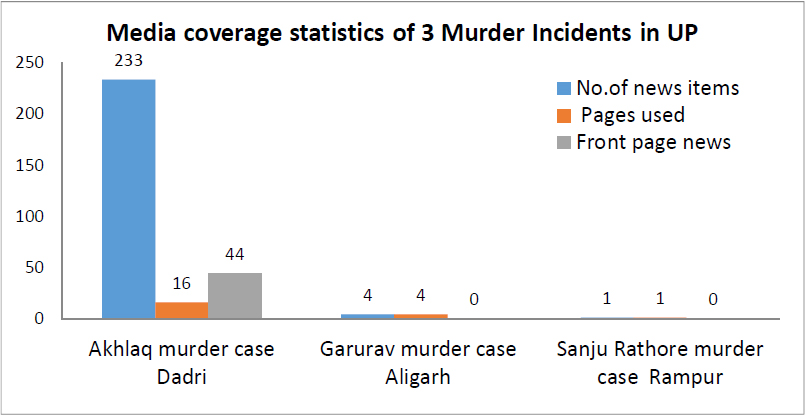
Figure 1: Media coverage statistics of 3 Murder Incidents in UP
Akhlaq murder case was reported 233 times in the selected five leading newspapers over a period of ten days and altogether 16 different pages were used to cover this incident, while Gaurav murder case got only 4 mentions in all the five newspapers and only four pages were used to cover the incident. Similarly, Sanju Rathore murder case got only one news-coverage in one page of one news paper. If, we talk about front page news then the Akhlaq news got front page space 44 times while the other 2-incidents got no front page news coverage at all in the selected 5-leading newspapers.
3.2. Statistics on Incidents of Atrocities against SC Youth
Sample Incidents –Una, Muzzafarpur and Godhra cases:
- Una, Gujrat, SC Atrocity Case (11 July 2016, Gujrat) : A youth belonging to Scheduled caste was beaten up by a group of people for skinning a cow on 11 July, 2016 in Mota Samadhiyala village, Una taluka, Gir Somnath District, Gujarat. One of those arrested was a Muslim teenager boy from UNA (Indian Express, 20 July 2016)v. It led to massive protests in Gujarat and several opposition political party leaders visited the site and highlighted the excesses committed on account of cow vigilantism.
- Muzaffarpur, Bihar, SC Atrocity Case (20 July, 2016): Two SC youth were beaten and urinated upon by some men allegedly for stealing a motorcycle. The incident took place at Babutola under Paru block in Muzaffarpur district. The two were locked in a room and later beaten up on the charge of stealing a motorcycle. The culprit’s nephew also urinated on the victims, the FIR said. The mother of the victim said her husband was also attacked and humiliated when he went to rescue the Dalit youth.vi
- Godhra, Gujrat, SC Atrocity case (26 July, 2016): A 20-year-old SC youth - Akshay Chauhan, a resident of Baharpura area in Godhra went in Phool Saiyad Society to meet a girl with whom he was in a relationship. The incident occurred when the boy was sitting on the terrace of the girl’s house and some other boys came to the girl’s house on motorbikes. They began shouting at Akshay and asked him to come down. The girl’s family members too were present in the house but the accused broke open the door and came in. The accused then began abusing Akshay and made disparaging remarks about his caste, the police said. “They were angry with Akshay as he kept visiting their area and spent time with the girl. The group thrashed Akshay and then dragged him out of the girl’s house. He was beaten up again and then the accused took him to a field nearby, where they thrashed him again. Akshay told the police that the assailants thrashed him with belts and sticks. The police said that some of the accused took out a sword and attacked him. He sustained injuries on his face and back but managed to flee from the spot and reached his house. Akshay also registered a case of loot against the accused for taking away Rs 3,000 and a mobile phone from him.vii
- Muzaffarpur, Bihar, SC Atrocity Case (20 July, 2016): Two SC youth were beaten and urinated upon by some men allegedly for stealing a motorcycle. The incident took place at Babutola under Paru block in Muzaffarpur district. The two were locked in a room and later beaten up on the charge of stealing a motorcycle. The culprit’s nephew also urinated on the victims, the FIR said. The mother of the victim said her husband was also attacked and humiliated when he went to rescue the Dalit youth.vi
- Godhra, Gujrat, SC Atrocity case (26 July, 2016): A 20-year-old SC youth - Akshay Chauhan, a resident of Baharpura area in Godhra went in Phool Saiyad Society to meet a girl with whom he was in a relationship. The incident occurred when the boy was sitting on the terrace of the girl’s house and some other boys came to the girl’s house on motorbikes. They began shouting at Akshay and asked him to come down. The girl’s family members too were present in the house but the accused broke open the door and came in. The accused then began abusing Akshay and made disparaging remarks about his caste, the police said. “They were angry with Akshay as he kept visiting their area and spent time with the girl. The group thrashed Akshay and then dragged him out of the girl’s house. He was beaten up again and then the accused took him to a field nearby, where they thrashed him again. Akshay told the police that the assailants thrashed him with belts and sticks. The police said that some of the accused took out a sword and attacked him. He sustained injuries on his face and back but managed to flee from the spot and reached his house. Akshay also registered a case of loot against the accused for taking away Rs 3,000 and a mobile phone from him.vi
The reason behind selecting these cases for a comparative study is that these incidents took place against the SC community in the month of July, 2016. Two of these cases are from Gujarat and one is from Bihar. Out of the two Gujarat cases, in one case only one community member was involved in the crime and in the other both community members were involved in crime but the the mainstream print media largely highlighted the majority community as bully. The statistics of coverage of all three cases is as below:

Figure 2: Media coverage of 3 Incidents of atrocity against Scheduled caste (SC) youth
It has been found in the study that Una case has got 38 news items and 11 different pages in all five papers for ten days, while Bihar case got two and one; Godhra case got zero coverage in ten days. It is evident that all these three cases were heinous crimes against SCs but the kind of coverage they got is disparate from each other. Similarly, Una has got front page coverage ten times while the rest of the two cases have got zero front page coverage.
In all the five newspapers, during first eight days, only five news reports were published about the Una incident. After the Dalit protest in Gujarat called by opposition and civil society organisations, the news coverage increased drastically and over the next two days, 33 news reports were published in these newspapers about the incident and the trend continued for several days. The Dalit victim was re-admitted in a hospital in Rajkot, hours before Rahul Gandhi’s visit.viii
3.3. Statistics on Incidents of Suicide due to caste based discrimination
Sample Incidents - Hyderabad and Villupuram suicide cases:
- Rohith Vemula suicide case (17 January, 2016): Rohith was a PhD student at the University of Hyderabad who committed suicide. He died after a controversy which extended over several months. On 3 August 2015, Rohith and four other ASA activists demonstrated against the death penalty for Yakub Memon, a convicted terrorist involved in the 1993 Bombay bombings. In response, the ABVP’s local leader Nandanam Susheel Kumar called them “goons,” after which Kumar was confronted in his hostel room.
- He stated that he was “roughed up by around 40 ASA members who barged into my room.” There after Rohit Vemula and four other ASA members were suspended andbarred from their hostel.ix After the confirmation of the suspension in January 2016, Rohith Vemula committed suicide and wrote a note in which he blamed himself for his suicide. His suicide sparked protests and outrage across India and gained widespread media attention as an alleged case of discrimination against SC(Dalit).,
- Viluppuram suicide case (23 January, 2016): Three girl students of SVS Yoga Medical College at Kallakurichi near Villupuram in Tamil Nadu committed suicide accusing the administration of charging excess fees and “torture”. They blamed the college chairman for their death. The bodies of the three were found in a well near the college. The girls were doing naturopathy courses.
- The two student suicide cases took place in January 2016 in the universities of south India.The data for these cases is given below:
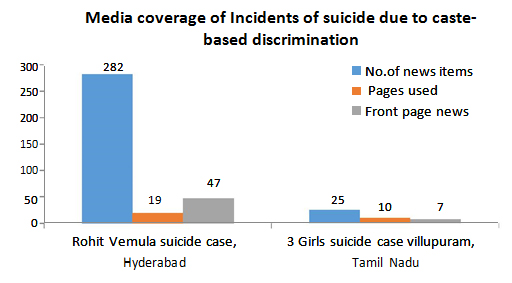
Figure 3 : Media coverage statistics of suicide cases
The media coverage for Rohith Vemula suicide case was much more than that for the suicide case of the three girls in Tamil Nadu and several opposition parties collectively blamed the central government for the issue.
4 Derivations and Observations
So, after analysing media coverage based on comparative studies of three most highlighted incidents on SC (Dalits) and minorities, particularly Muslims in last two years, it can be learnt that media reporting gives differential weightage to incidents of similar nature. On the basis of research, it is evident that few cases were more highlighted by media while few similar cases were surprisingly being left out.
4.1.Selective reporting and Political escalation - While the responsibility to protect law and order is with the State Government, the opposition and some section of the media blamed the Central Government. Often such selective reporting is followed by political escalation by opposition parties to tarnish the incumbent establishment. Deriving from the incidents taken in this study, the same was observed.
- The special weightage given given Dadri Akhlaq murder case, fetched huge political escalation of the incident, while ignoring the others of similar nature. Intellectuals like Nayantara Sehgal and Ashok Vajpayee returned their awards saying the incident reflected increased ‘intolerance’ in the country and the incumbent central government is responsible for the same. Following their suit, a slew of intellectuals also returned their awards on account of rising intolerance in the country.x
- Similarly, the selective coverage given to unfortunate incidents of atrocity and discrimination against the Scheduled Caste youth fetched widespread political escalation, painting the incumbent establishment ‘anti-dalit’. The unfortunate death of a student in Hyderabad was used as a tool of political vendetta and media propaganda. And so was done, in violence against SC case of Una, Gujarat.
4.2. Ignoring Crime follow up and Colouring of facts- It was observed that certain cases were made icons of atrocities against marginalised communities – Scheduled castes and minorities, particularly Muslims, through selective reporting and political escalation. However, the follow up investigation of these unfortunate acts of crime were ignored.
- The print media depicted Rohith Vemula case as a reflecting the general anti-Dalit stand of the establishment. However, it was later found out that the incident stemmed from a political rivalry between the two student groups. It was also revealed in the judicial commission that Rohith was not a Dalit.xi
- Similarly, reporting of the Una incident in Gujarat, the upper-strata of the majority community was painted as some arrogant bully through such selective reporting and political escalation. But, later it was found that one of the members of the group that committed the crime was from the minority community
4.3. Differential treatment to incidents of crime by the media – Besides the 8-incidents taken as samples for comparative analysis here sharing similar nature, there were some more related cases that occurred over the same time period were studied in the same newspapers. These cases are as given below:
- Two engineering students commit suicide (20 January 2016, Indian Express, Page 11)
- Prem Prasad (22-year-old final year engineering student) commits suicide in Vijaywada (Andhra Pradesh) (Prem was from the Madiga community from Vallur village of East Godawari district) (25 January 2016, Indian Express, Page 10)
- 10-year-old SC girl was brutally raped and killed in Nawabganj, Anandpur, Bareli, UP (31 January 2016, Jansatta, Page 5)
-
Bharat (65), Mamta (60) – A couple from SC community attacked with axe and killed in Mainpuri district, UP ( 29 July 2016, The Hindu)
- An SC women forced to drink urine in Pipra village of Darbhanga, Bihar (31 July 2016, Times of India, Page 17)
Out of these five cases, the first took place in the same month as the Rohith Vemula case. The first case of suicide by the two girls took place just 3 days after the Rohith case but the coverage these incidents got was negligible compared to Rohith. The second case happened eight days later. It was very similar to the Rohith case as it also took place in Andhra Pradesh and the victim was a student of final year graduation and also belonged to scheduled caste community. He was 22-year-old - 4 years younger than Rohith - but the coverage it received was very poor.
The third case happened after 13 days in Uttar Pradesh. A 10-year-old girl of SC community was brutally raped by a group of men who also inserted wood into her private parts, killed her and threw her body in a farm. The case took place in Nawabganj, Anandpur, Bareili, UP. The case received meagre coverage as compared to the Rohith case despite the fact that it took place at a time when the entire country seemed to be outraged over the atrocities against SC (Dalit) vis-a-vis the Rohit case. The reason behind the silence in media and civil society organisations over the incident is still unknown.
The incident number 4 and 5 listed above occurred at the time of Una case of atrocity against SC. In the fourth case a senior citizen couple belonging to SC community were killed in Mainpuri district, UP - a constituency of powerful politician of the state. The case did not get media attention. In another case, a Dalit woman was forced to drink urine in Pipra village of Darbhanga, Bihar. Somehow, again, the case escaped the media glare.
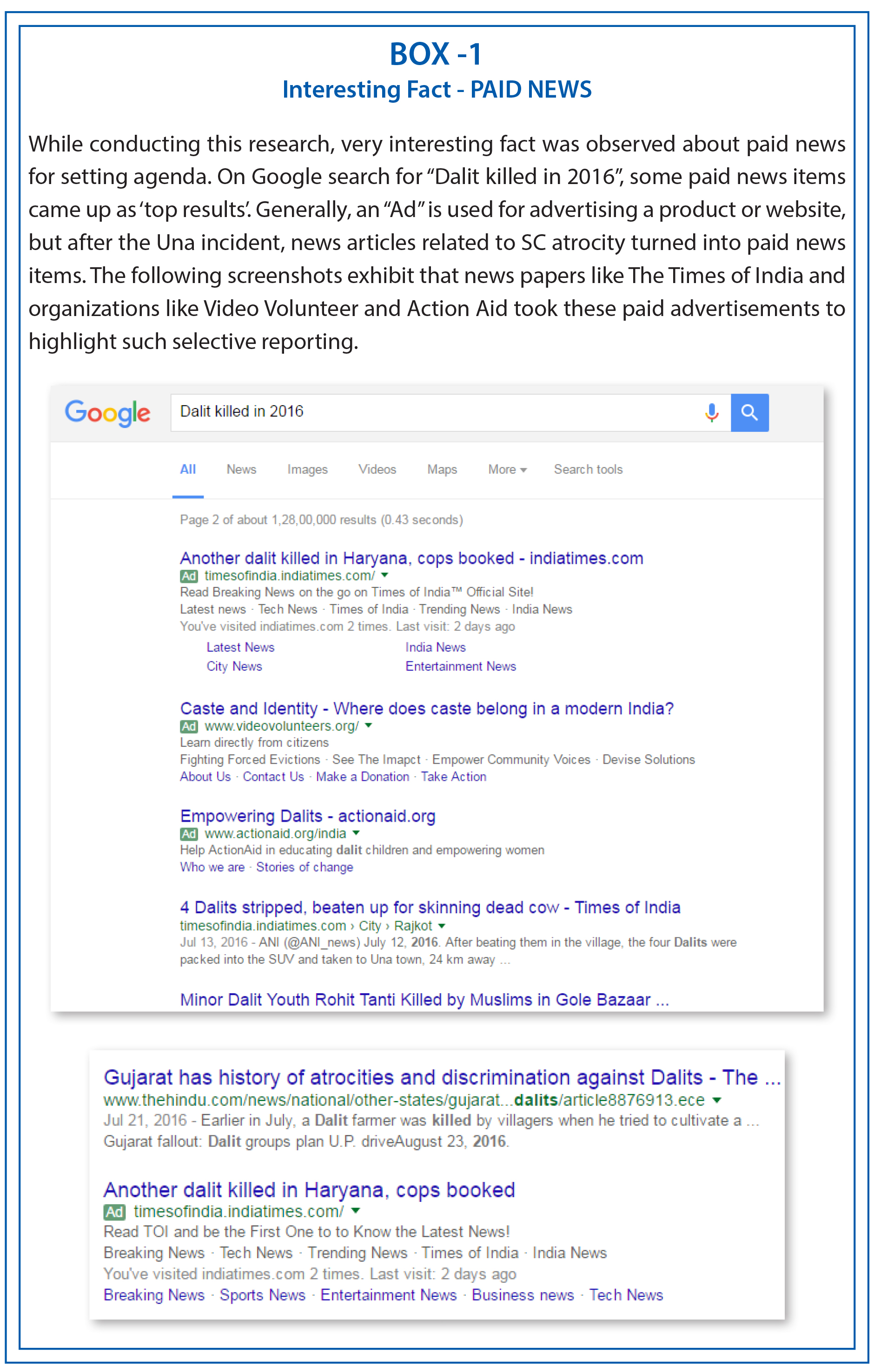
4.4. Lop-sided Agenda setting and shaping Public Opinion - After studying the media coverage on brutal incidents of crime against the marginal communities – the eight sample incidents and the other five cases listed in the previous section – it can be clearly observed that media does selective reporting and gives differential treatment of such unfortunate incidents of crime. It has been observed that such selective and biased journalism unleashed unrest across the country, painted the establishment communal and ‘anti-dalit’, and disturbed the society. The widespread public opinion came to be that crime against scheduled castes and minorities are on steep rise. Media overreach transcended the boundaries of public interest activism and manufacturing of opinions led by vested interests and sensationalism
In order to understand whether it is actually so, this study brought more reports under the ambit of the research. Contrary to this Public Opinion shaped and Agenda set by selective reporting by Media in the timeframe taken for research (2015, 2016), on analysing trends of Crimes against marginal communities by National Crime Record Bureau and National Commission for Minority, it was found that the numbers are falling. The following data exhibits the same:
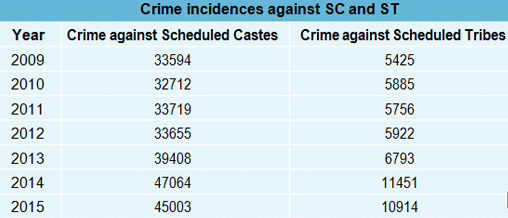
Table 3: National Crime Record Bureau Statistics
Table 4: National Commission for Minority data
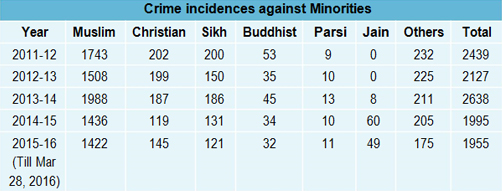
In table 3, the crime data graph shows a rise in incidence of crime against SCs and STs from 2013 to 2014 and a noticeable decrease thereafter, which is contrary to the public opinion shaped by the selective media reporting done in this timeframe – i.e. after 2014. Similarly, in Table 4, analysing crime data of all minorities, it is learnt that post 2014 these incidents have declined.
The NCRB data and NCM data reinforces the research finding that the media projections on caste conflict firestorm in the nation and communal agenda setting by the media are questionable to the extent of their unjustified tilt towards one particular incident and disregard to similar cases of similar gravity. This agenda setting and public opinion shaping role of media is unethical and definitely puts a question on media delivering justice.
5 Concluding Remarks.
This research began with a question as to whether certain news media organizations tend to compromise with the cardinal principles of journalism, viz objectivity and non-partisan character while covering news of atrocities against SCs and minorities, especially in the last two years. Having scanned through relevant news-stories, their content in general, the choice of terminology, placement of the news, space given for the news and also fonts used or not used, this study was able to reach some important conclusions after a thorough, objective analysis.
- Compromising Media Ethics - There is enough evidence to suggest that a particular pattern seems to have been observed while reporting certain unfortunate incidents during the period under report. Every news is sacred and not adulterating the core news with views and biases is the fundamental principle of classical science of news reporting. However, evidence suggests that incidents of almost exactly similar characteristics are given differential treatment. This discrimination is evident through many factors. Mainly, these factors are : placement of the news item, space devoted for the news, fonts used, choice of vocabulary and judgmental style of descriptions all this leading to creation of a poisonous cocktail of news and views. This underscores the growing tendency of compromising with the basic media ethics of protecting the purity and sacredness of news. This has, unfortunately led to a grave injustice to the readers as they read news sections of journals for just news and not views ( for which space on edit pages is always there)
Differential handling of news about similar incidents happening in different parts
–A comparative analysis of pattern of coverage of similar incidents of crime against the SC and minorities taken here for study clearly reflected the selective importance attached (or the inexplicable lack of it) while reporting by certain news papers. Some incidents were widely covered; with repeated follow-up stories, while others of similar gravity were hesitatingly reported or almost ignored. What was more alarming wasthat the tone, tenor, direction and vocabulary of coverage in the key highlighted incidents were uniformly directed to the disadvantage the ruling dispensation allowing the politicisation of a criminal incident. This not only involves denial of equal justice to the victims of ignored incident but also to the respective state government, the incident from where is disproportionately highlighted. Besides, since it involves denial of even-handed treatment to news-items --about similar incidents-- being served to the readers, justice is also denied to them.
- Denial of Media Justice - Above all, the objectivity and credibility of the media comes under question in this process of selective and biased reporting. This repeated disproportionate coverage to some chosen cases misleads the readers and common citizenry, and eventually they perceive it as ‘political reporting’ . This perception endangers objective analysis of socio-political conditions. This may, at times lead to a situation where a real threat to social security of marginal communities is grossly overlooked.
- Devaluation of news reporting - Such kind of selective and biased coverage only creates sensationalism without either resolving the cause of atrocities or ensuring justice to the victims. In democracies, readers have the right to know facts without adulteration, and news media is the principal vehicle for news delivery. But when news reporting smacks of a clear partisan or political agenda, largely emanating from prejudices or biases; news reporting as a process and news papers as an institution tend to lose their credibility.
6 Recmmendations
After analysing the facts presented in this study, it can be said that a section of mainstream print media has deviated from ‘objectivity, unbiased and non-partisan journalism’ while reporting the incidents involving grave crimes, particularly against the scheduled castes and minorities; in States governed by certain political dispensations. In order to ensure that this perversion is not institutionalised , this study recommends the following :-
- Establishing Un-Adulterated News Content Quotient (UNCQ) - It is strongly recommended that the Press Council of India and organisations like the Editors’ Guild should seriously consider establishing a mechanism to asses the objectivity of news reporting periodically through evolution of parameters like Un-Adulterated News Reporting Quotient ( UNCQ). Periodical publishing of Reports after assessing the quality of news reporting on this quotient will go a long way in helping readers selecting a provider of objective news.
- Evolving a Common ‘Style Book of News Reporting’ – Keeping the principles of media ethics and media justice, it is urged that media organisations - both, print as well as electronic -- should come together and evolve a Common Style Book of News Reporting to facilitate usage of proper, uncoloured vocabulary and non-judgmental terminologies, thereby ensuring justice to the readers.
- In-House mechanisms to ensure non-discriminating reporting – Abiding media ethics, we appeal Media organisations to evolve in-house mechanism to keep a constant check on differential reporting. An internal audit of Space allotted, Coverage Extended, Fonts Chosen and Terms/ Words Used for Reporting of Similar Incidents in a span of time could be periodically undertaken by the media houses to ensure ending the practise of Differential News Reporting
- Institutional Checkpoints – The Press Council of India (PCI) must intervene before media ethics are buried deep beneath the debris of biased reporting. At first, PCI needs to evolve a syllabus for all media and journalism teaching institutions for unbiased, unadulterated news reporting. Later, other mechanisms like observance of a voluntarily accepted News Reporting Code, Rating of Journals and Media Houses and instituting Objectivity Excellence Awards also are required to be thought of and implemented.
References
(Endnotes)
i.McCombs Maxwell, The Agenda-Setting Role of the Mass Media in the Shaping of Public Opinion. University of Texas at Austin.
ii.http://indianexpress.com/article/india/india-others/next-door-to-delhi-mob-kills-50-year-old-injures-son-over-rumours-they-ate-beef/
iii.http://www.tribuneindia.com/news/nation/aligarh-tense-after-commUnal-clashes/158277.html
iv.http://indiatoday.intoday.in/story/15-year-old-boy-dies-in-rampur-commUnal-clashes/1/455258.html
v.http://indianexpress.com/article/india/india-news-india/Una-SC-thrashing-muslim-boy-among-two-more-arrested-by-police-2922028/
vi.http://www.ndtv.com/india-news/2-SC-men-allegedly-beaten-urinated-upon-in-bihar-1434691
vii.http://timesofindia.indiatimes.com/city/vadodara/SC-man-thrashed-over-affair-in-Godhra/ articleshow/53425501.cms
viii.http://indianexpress.com/article/india/india-news-india/SC-victim-re-admitted-to-hospital-in-rajkot-hours-before-rahuls-visit-2928535/
ix.http://indianexpress.com/article/india/india-news-india/SC-scholar-rohith-vemula-the-student-the-leader/
x.http://www.hindustantimes.com/india/and-it-continues-kundan-shah-saeed-mirza-join-award-wapsi/ story-t7guKRzkGv7ZrsTY6vOMZJ.html
xi.http://indianexpress.com/article/india/india-news-india/rohith-vermula-suicide-rohith-was-not-a-SC-probe-panel-set-up-by-hrd-2993324/
ABOUT PPRC
Public Policy Research Centre (PPRC) is a research organization established in 2011. The Centre aims at constructively impacting the policy formulation process with emphasis on good governance practices, efficient implementation mechanisms and evidence-based policy-making including policy-audit and evaluation, in the larger interest of the nation.
Public interest is of paramount importance in a democracy. No democratically elected government can perform its duties as the custodian of public good without evidence-based research. Solid research is a prerequisite of sound policy formulation and design making. Dispassionate and objectively conducted research enhances democracy as it can reduce the ability of those with vested interests to influence the public policy debate. The idea behind PPRC is to undertake structured research and carry field-study projects to explore constructive solutions on important policy issues in an institutionalized manner, through discussions, debates, seminars, study circles and brainstorming sessions.
Since its inception, PPRC has worked on several short-study projects as well as full length research products and has come out with occasional papers, study reports, research-tools and similar publications.
Board of Directors
Dr. Vinay Sahasrabuddhe
Adv. Nalin Kohli
Dr. Sumeet Bhasin
Shri Rajendra
PPRC- PUBLICATIONS:
1.Making Villages Open Defecation Free: Issues in institutionalization of success. (August, 2016)
2.Jo-Kaha, So-Kiya
(Implementation on Assurances made in the Election Manifesto by Modi Government during 2-year of office) (June, 2016)
3.Antyodaya
(Justice and Welfare to the Deprived: Value addition made by Modi Government) (April, 2016)
4.Politics of Performance
(A Comparative study of delivery of Good Governance by different political parties in India)(December, 2014)
5.Reference Web Director on Public Policy Issues
(Compiled list of web links of various government ministries, departments and civil society on policy issues)
6.Fact Sheet on Communal Riots in India
(Occasional paper on communal riots in India)(May, 2013)
7‘Socio-Economic Development Policies for Manipur and Nagaland (Strategies for Strengthening the Policy Framework)(July, 2015)
8.Foundation for providing skills for life and livelihood through Elementary Education (Outline for Policy Framework) (September, 2015)
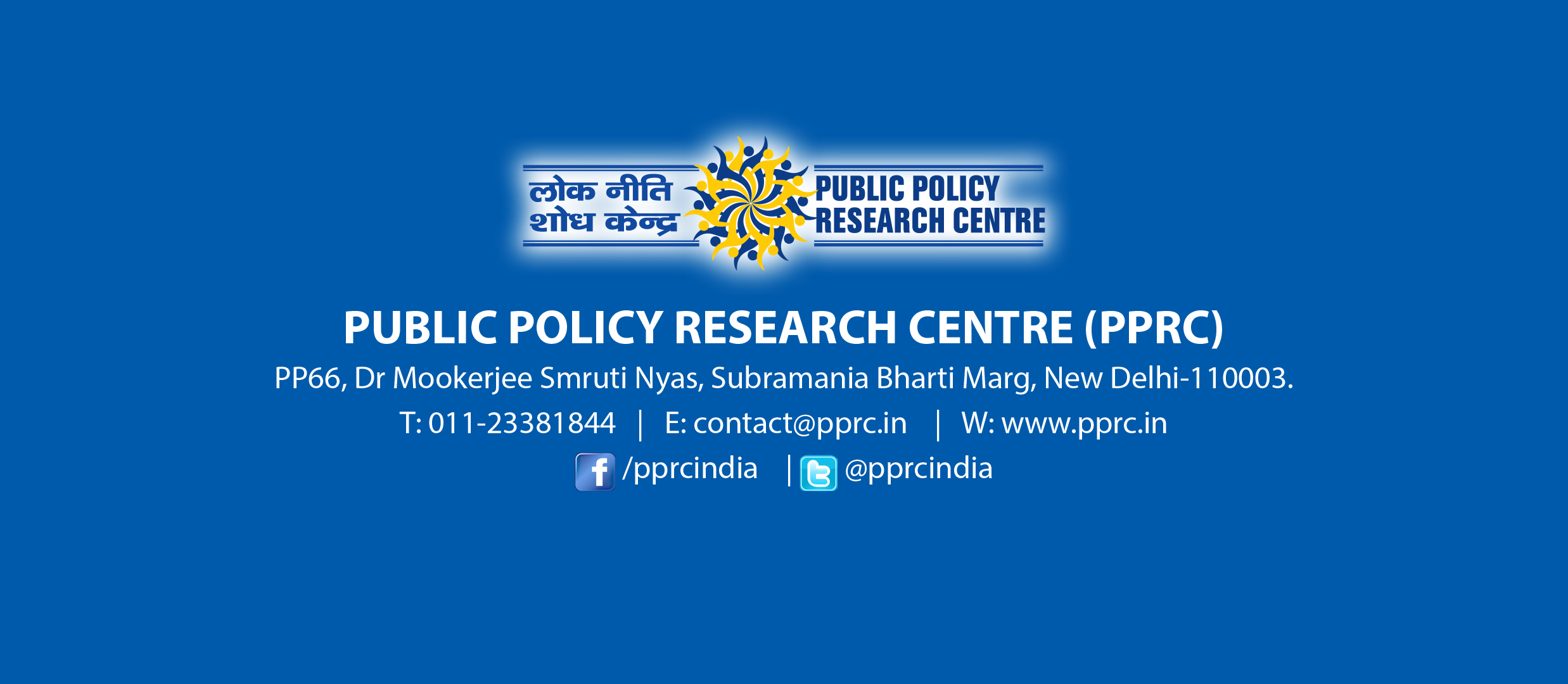
Published with the permission of Public Policy Research Center



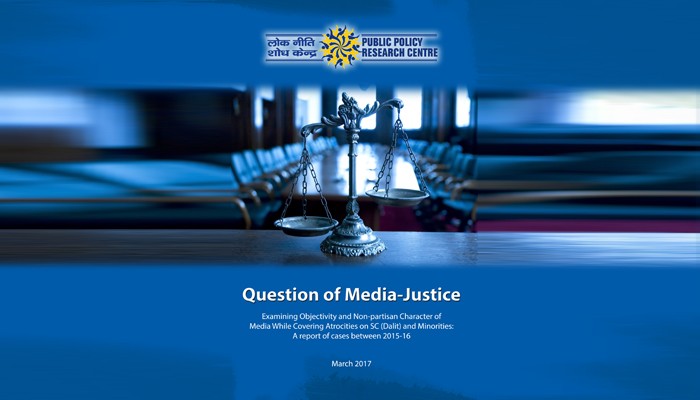



Comments